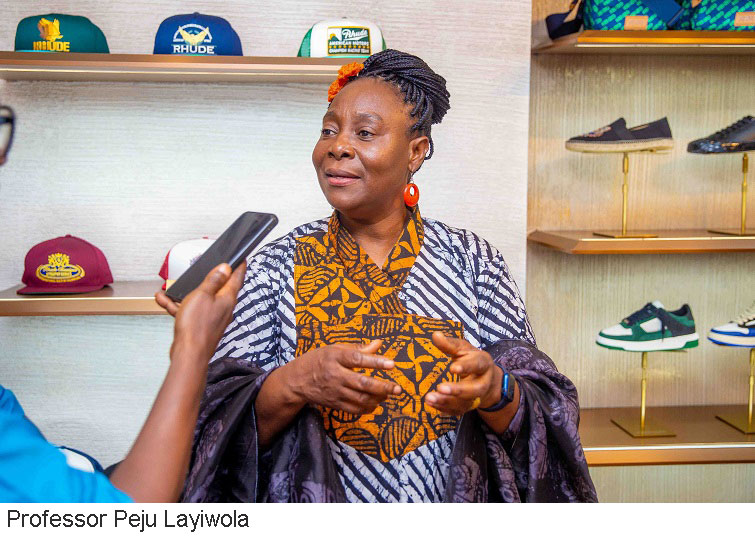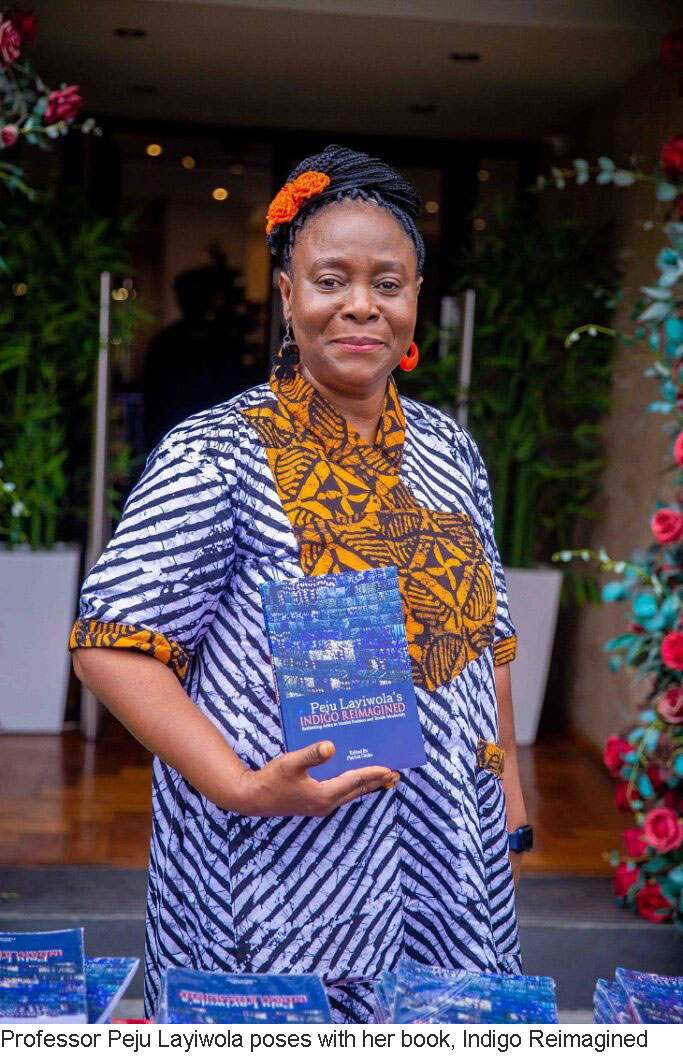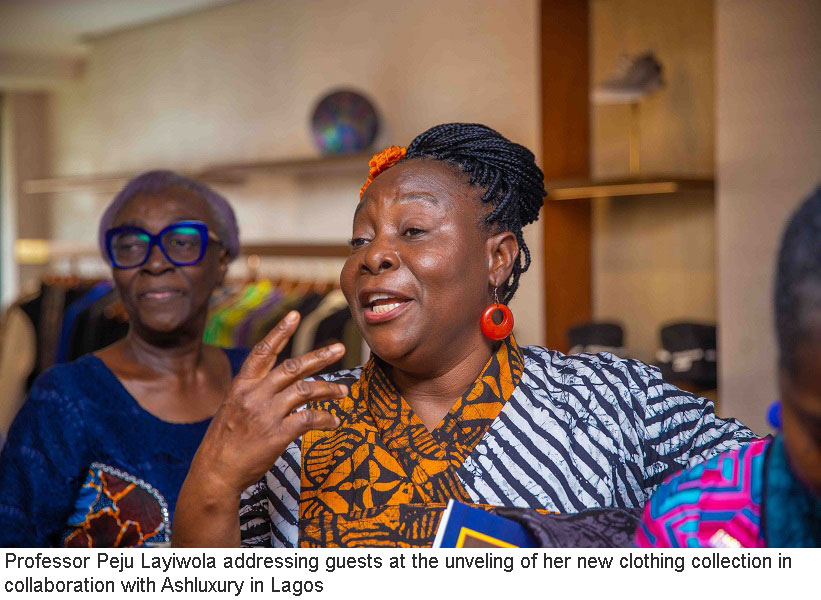
Category: FABRICS
Country: Nigeria
Saturday, December 24, 2022 11:01 am
Professor Peju Layiwola, a distinguished art historian in the Dept of Creative Art, University of Lagos is not just an artist, she was born into art. Her engagement with textile and design, which she has made to acquire deep cultural and historical significance began with her early involvement in art workshops led by her mother Princess Elizabeth Olowu (nee Akenzua) in Benin-City.
Aside from being a distinguished academic, Layiwola has been able to unite the town and gown as well as theory and practice by virtue of the many exhibitions, trainings and workshops she has organized both locally and internationally. She has also championed the repatriation of looted art works from museums across the globe.
In 2019 she organized a groundbreaking solo exhibition at two venues in Lagos, Nigeria, which lifted adire, a popular local fabric beyond the ordinariness of cloth to acquire a high social significance. That exhibition inspired a major work, Peju Layiwola’s Indigo Reimagined which was presented to the public in Lagos recently. In this interview with NEHRU ODEH, she speaks about her first contact with art, her interventions in textile and design, as well as the social significance of adire, a fabric she has elevated into an art form both locally and globally.
Could you speak about how you first had contact with art?
(Laughs) That’s a very good question. I think I have always done art because my mother was an artist. And growing up as a young girl, I was inspired by the things she did. I didn’t even know the value of what she was doing. So, sometimes we would take her materials, use them the way she used them and mess them up sometimes and she would get upset. What was interesting is that she always incorporated us into her own works. And so, she would take me to the University of Benin, where she was studying and I would model for her. There was a particular work she did, which is titled Acada and one of the first sculptures that came out of the University of Benin because she was the first set of students for the art school at the University of Benin in 1976. That work was kind of autobiographical for her because it was about how she was called Acada when she was growing up. She used to read a lot when she was a young girl. And at the same time I posed for her. So, both of us were represented in that work because I sat for her to do it. Though the story is hers, the features are mine.
And when she was hired by the then Bendel State government to do workshops for market women, I would go with her because I had already learnt the things she was doing. She was always working. She was a workaholic. In fact, everybody who knew her talk about that quality. So, at every step in our growing up we saw one thing that she had done, in progress, and it was very easy for us to get into the mood of it. She never sat us down to say, go and do this, this is how to do this. We just saw and did it and it was natural. Although she taught me in secondary school. She was my art teacher in the secondary school in Benin for a few years. So, art has always been part of my growing up.
Would you say your mum influenced your art?
Incredibly. My mother and also the environment – growing up in the city of Benin. Benin was a beautiful and amazing space where there were so may artists, so many workshops along the streets, all the galleries in Airport Road to Igun Street. It was just art making, art everywhere. So, I was inspired by that.
 How did your love for adire start?
How did your love for adire start?
That actually has always been there. Because I learnt the processes of batik and tie and dye from my mother. Like I earlier said, I was always going to workshops. That featured prominently in her workshops. It was only when I moved to Ibadan, and that was when I got married in 1994, that I began to see and look at it more closely in a more scholarly manner. Otherwise, I had been doing it. But I am now understanding what it meant to the culture. And this was a vital part of my identity, a vital part of our knowledge system, more so understanding the gender dimensions as well of this art that is done by women and the work that is done communally. So, I began to understand those layers of meaning. And I began collecting because my husband is also a great collector, a fan of textiles. I said he is even more passionate about textiles than myself. And also, he is from Iseyin, a town very well known for weaving. His father was also a very cultural person. My husband was also Director of the Institute of African Studies, University of Ibadan and so he is well aware of the culture, the beauty of not just textile but the general indigenous knowledge system, language, orature, all of that. He also made me to see. Because I was looking, I wasn’t seeing. He made me see and understand the beauty of this aspect of the culture. I began to collect textiles from that point and over the years it just expanded to my work as someone who teaches in the local spaces, in communities though my NGO work. Yeah, it has always been there. Textile has always been there. Even from my mum, I would say projects that I have looked at, repatriation, restitution. There is always a dimension to textile. But you don’t see because the message is very strong. And so, I just felt I should bring it up in my 2019 exhibition and to celebrate it. I wanted something very celebratory and not just doing art because we are always making strong statements about returning Benin artifacts. That was a very emotive topic but I wanted something that was more flowery and I turned to textile.
Could you speak on that ground-breaking exhibition of 2019 that held in Lagos. How did that exhibition lead to the book, Peju Layiwola’s Indigo Reimagined: Rethinking Adire in Yoruba Fashion and Textile Modernity and what is its significance?
That exhibition was actually a time of signing off. I knew that people were very interested in textiles in Nigeria but I didn’t expect the kind of reaction and the discourse that it generated. I had finished with this topic on repatriation. I went into another topic that was really topical. And the response was amazing in terms of the questions that people were asking and the depth of interest that people showed. So, people were arriving at the venue because they were not coming to see a mere exhibition. They were coming to celebrate part of their culture on their own understanding. So even in the collection of textiles that I had in one of the installations people could identify that their grandmothers had those fabrics. Because fabric is like capturing a historical time. When a particular design comes out, people acquire it. It just goes. It’s fashion. So, if you have this shirt, this particular design, everybody has it that period. And it goes out of fashion. That’s it. It’s a timeline. It tells you that. So, people were like, Oh I grew up having this. My mother had this. I have this colour. So, they could relate with you. It wasn’t detached. Cloth is like a second skin. And I think that because of the very presence of fabric in our lives, it’s gained a lot of currency. And it also something to celebrate. Fabric has always played a vital role, and has also been incorporated into proverbs, idioms and all of that, in the importance of communal life, which is also expressed in the processes of the art itself., Because people talk about Eniyan ni aso mi, which, translated inti English means: People are my covering, people are my cloth.
Your work is also remarkable in th e area of return, as it relates to Sarah Baartman and stolen artifacts. Could you speak on that?
Return is something I began looking at when I visited Vienna in 2007, in terms of looking at the exhibition that held/, the works that were looted and taken from different museums around the world. So it was an instant reaction to that exhibition. Although I had been working on this since 2003 on a project with a French anthropologist who came to do surveys in Benin-City, asking about what it meant for these works that had been taken away from a particular community and getting the responses of people who felt that there was this lacuna. So, going to Vienna made it more real for me to react. And then I gave a lecture that brought the exhibition, Benin Kings and Rituals: Court Arts from Nigeria, which was a travelling exhibition that started in Vienna, moved to Paris, Berlin and closed in Chicago. In that exhibition I gave a lecture that brought it to a close in 2009 in Art Institute of Chicago. I returned to Nigeria and nobody was talking about this repatriation, nobody was talking about the exhibition and the works. And I felt that I needed to bring this thing back. I think people were already despairing about the request in 1976 for the FESTAC mask. I think generally they were just lackadaisical. I felt that an exhibition would bring it back to the prom. And exactly that’s what happened. People started asking questions: Where are those works? And the whole discussion came back on the front burner locally and internationally as well because people were protesting about Benin works. So that was the major contribution that I made. And I began to give lectures in different parts of the world about Benin looted art and also tied it up with advocacy. People were also mentioning this in the context of human remains that were taken, bones from Namibia, Sarah Baarthmann from South Africa and all of that. So, all of these things became very heavy in my work.
How has the fact that you are a Benin royal princess affected your art?
Well, people say I’m Benin. But I’m also Yoruba. My father is from Lagos State, but I grew up in Benin.
 But you were more conversant with the Benin tradition.
But you were more conversant with the Benin tradition.
Yes. But I also did not want to forget my other lineage because both of then add up to whom I am today. And I think I occupy this very privileged position of being Edo and being Yoruba.
How has that marriage of two cultures impacted you?
It’s such a beautiful thing for me because I have the opportunity of looking at these two rich cultures and having access to them, which is such a wonderful thing for me. And I think that is the beauty of my art, being able to switch and go both directions. It helps me a lot. It is not unidirectional and so it has given me a lot of materials. So, I cast that as backdrop against my production and it has helped me a lot.
You have been known for linking the town and gown. Could you speak on how your work has been able to link the town and gown?
I think I mentioned that in the text in terms of the work I do – NGO – working with disadvantaged populations, youths, women, which has been recognized by foreign governments like the United States. Then the master art classes, which I run – which is another platform. We have people connecting from everywhere in the world interested in learning about artistic traditions. So, we have this online. And we also have interactive sessions with them. Then also try to bring in collaborations between industries, between well-establish organizations like this (Ashluzury), with universities and so fostering that kind of connections, connections with such entrepreneurial spaces and bringing our students to see the possibilities that exist. So that has been my artistic trajectory. I have never left that. I have always been part of it. Yes, I’m an academic, I write, but I also I think that all that we do as academics would make more meaning if we situate it within the communities that we serve and where we come from.
You’ve done a lot of works and trainings both within and outside the academia. Could you speak on how you have been able to impart them with your knowledge and art?
Incredibly. There is so much that is going on. And we get feedbacks. People write back and tell us. We are not concerned about you writing us directly. What we are interested in is – seeing that there is a lot of poverty in Nigeria – how can we make an impact in your life without you seeing us. Because the work is enormous. How do we train all the youths in this area, for example?. It’s very cumbersome. So, we have created the first training materials in Nigeria on textiles. How to do particular things, not just textiles. How to do piece-stringing, goldsmithing, pottery with intensities that went viral. And they were available everywhere in the country and beyond. We don’t even know where our materials went. But it’s been able to inspire a lot of people and we get feedback. People call and tell us that, Oh I have set up this cottage industry, I have set up this business, I have got an award here because I use your materials. And I’m grateful for that. I think that’s true development. That’s true impact.
What are you working on now?
(Laughs) I’m always building up projects. In fact, I was going to announce to the audience that this is the last project for the year. I’m very active. You heard my husband say that I’m always doing one thing or the other. Yes. I’m always busy. You see, if you grow up in Benin-City where people are hardworking and they grow up with an excessively hardworking mother they are bound to be hardworking as well. I think I’m doing all of these now because in the next five or 10 years I should be resting from my efforts. If I’m teaching people to be empowered, I should be empowered by what I have done so far. I think I’m getting to the point where I can just ghost (laughs).
Courtesy: https://thenewsnigeria.com.ng/2022/12/24/why-adire-fabric-means-so-much-to-us-prof-peju-layiwola/
Copyrights © 2025 GLOBAL TEXTILE SOURCE. All rights reserved.